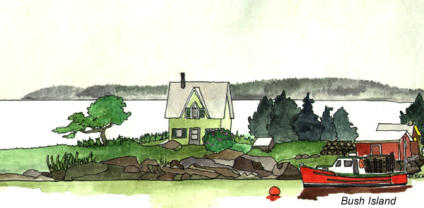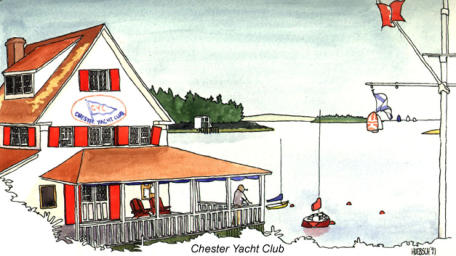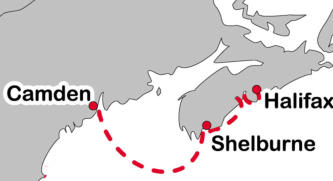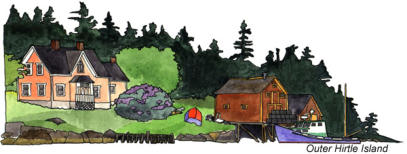Chapter 2
Of Ships and Whales or Indecision in the Gulf
Aug to Sep 1991
In Nova Scotia we picked up an excellent booklet: East Coast Marine Weather Manual issued free by Environment Canada;
the chapter on fog starts with a quote from an anonymous fisherman:
“Sometimes out in the Bay of Fundy when the fog comes in thick you can sit on the boat's rail and lean your back
up agin' it. So that's pretty thick fog out there; but you gotta be careful 'cause if the fog lifts quick, you'll fall
overboard.''
Our progress slowed down a lot in south west Nova Scotia—mainly because of adverse winds and the above mentioned fog.
It rained for six of the seven days we spent in Halifax, and then after one sunny day we left to sail around Sambro Head to
St Margarets Bay. The wind didn't last though and we pulled into a perfectly sheltered uninhabited cove—Cub Basin. Next
morning we tried again in light winds, but the fog started to roll in so we headed for East Dover where a fisherman advised
us where to anchor and presented us with three cod. In the afternoon the wind came in briskly from the south east and
blew away the fog so we set off again and had a splendid sail to Mahone Bay with its dozens of rocky pine-clad islets and
into a sheltered anchorage in the Back Harbour of Chester.
It was Race Week in Chester, one of the biggest regattas on
the south coast, and here one of my preconceptions, that
Maritimers are all good seamen, was smashed; I saw as
many examples of inept anchoring as I have seen anywhere.
But then these were racers, not cruisers. The crew of the
boat next to us, after tossing a tiny Danforth out of the
cockpit went ashore only to have their boat drag in the
night. I found out later that the skipper was the vice
commodore of a yacht club.
Chester is a pretty little tourist town and we spent a couple
of days here sketching and painting before leaving on a
bright sunny day for Lunenburg, twenty miles down the
coast and past rocks with reassuring names like Hell
Rackets. Here Oborea was back in familiar waters and we
dropped the hook in her old spot in the harbour. It was mid
August, the middle of the season and I was surprised at how
few yachts there were around. Those we did see were interesting ones though, schooners, cat-boats, old wooden ketches
and so on.
Spent four sunny days exploring and painting in Lunenburg which is as pretty and
unspoiled as ever, but as we prepared to leave we heard news of Hurricane Bob heading
up the coast so we decided to stay put. I ran out the sixty pound CQR anchor and Iris
was interviewed on local television in full foul weather rig. Bob, when he finally arrived,
was a bit of an anticlimax, a night of 35—40 knot winds and rain and sunny skies next
day as the wind blew itself out. On the following day we set off for Shelburne but once
out to sea we found heavy seas still left over from Bob so we turned and ran in to the
LaHave Islands where we anchored (in fog) in the Folly Channel. Here we found old
friends; the ex lighthouse keepers of Mosher Island (they lost their job last year when
the light was automated).
Tom still works part time for the coast guard and in summer they still live at their farm
on the island in a part of the barn converted to living quarters. We spent the day helping
them harvest produce (and stocking up Oborea) and in the evening we all went ashore
to dinner with friends. As we motored back to the island after midnight the air was clear
and cool (after three days of fog) the moon was full and there was a wind from the north
east. Now was the time to leave. This coast was taking just too long as the season was
progressing rapidly. Summer here is pretty well over by the end of August.
By half past midnight the anchor was up and by ten past two in the afternoon we were
turning for the seven mile run up the harbour to Shelburne. With the wind on the beam
we were hitting ten knots in the gusts. A man on the public dock directed us to a vacant
yacht club mooring and when we dinghied ashore he introduced himself as the Vice
Commodore of the Shelburne Harbour Yacht Club. He told us a friend had called him
from five miles down the harbour to say that a visiting yacht was on its way in and he
had better hurry because she was "really flying!''
Shelburne is a historic town, one of the first loyalist settlements with many nineteenth
century buildings and a museum. It also has a dory-shop/museum where a ninety year
old man who has worked there since he was thirteen still comes in a couple of days a
week to putter.
The south east corner of Nova Scotia has many off-lying rocks and
islets, dangerous tide rips and sudden fogs. We decided to give it a
wide berth. We would take advantage of the prevailing south
westerlies to get well off shore on the starboard tack and then come
about and head for Bar Harbor Maine. A good theory that did not
quite work out. The first time we left we found the winds just too
strong to make the journey pleasant and we put back to the shelter
of McNutts Island. Next day the winds were light and we spent all
day creeping slowly off shore. In the evening the fog returned and by
dawn next day we had made good only fifty miles. That dawn too
brought our most eerie encounter with whales.
We had by this time often heard whales breathing near us at night or in the fog, a sudden whoosh of breath. In fact even in
good visibility the sound of a blow was often our first hint of them. But
this time it was different; it was loud and there was a resonance like a
giant blowing down a thirty six inch water main. It sounded close
alongside as if we should be able to look right down the blowhole, but
in the pale dawn light and the mist we could see nothing. This
continued all around us for fifteen minutes until we finally saw a great
head emerge from the water very close, turn slowly around and subside
leaving a swirling roil of water. This was repeated a couple of times and
was all we saw of the whales although the sounds continued for
another fifteen minutes at least.
When the time came to tack toward Maine the wind, of course, turned against us and so we made a new decision. We had
been held up by weather enough in Nova Scotia and we had had enough of fog and rocks. New England was likely to be
more of the same. We were ready for warmer waters, and so we decided to sail straight across the Gulf of Maine two
hundred miles to Cape Cod. As if to bless our new plan the sun broke through the fog in the afternoon and lifted it
completely. I was able to fix our position by the sun while all around us flocks of petrels and phalaropes were feeding and
shearwaters skimmed the wavetops.
We continued heading westward all next day even after the wind
backed to the south west, until in the evening we picked up a
forecast of a strong front coming in from Québec that was to be
followed by north west winds of nearly gale force. We did not
have time to make Cape Cod and we did not want to have to run
before it out to sea, so we made another decision: we would run
for Penobscot Bay ninety miles to the north and try and beat it.
It was a wild night running before the increasing south westerlies
ahead of the front under close reefed sails and of course the fog
came back. RDF fixes in the morning put us near Matinicus Rock
off the entrance to the bay but we could see nothing, neither could
we hear the foghorn on the rock. The wind had eased a bit and we
went on more slowly until we finally heard the faint sound of a
whistle buoy on the port beam (where it should be) and a few
minutes later the rock and its lighthouse loomed out of the fog a quarter mile ahead and even at that distance we could
scarcely hear the fog horn. A sobering sight was thirty feet of shiny aluminium mast with sail still attached poking out of
the sea close against the rock. Just past the rock, which is still a few miles offshore, a fin whale surfaced close beside us on
a parallel course before cutting close across our bows. I don't know how we avoided hitting him.
Two Russian factory fishing ships overtook us on the long sail in the rain up the bay to Camden before the sky cleared and
the sun came out. Camden is one of the sailing centers of Maine with a fleet of large charter schooners taking out
sightseers and many huge yachts in the tiny inner harbour. We anchored in the spacious outer harbour near a big scow
schooner and the wind, which was now north west, swept out of the hills in violent gusts.





